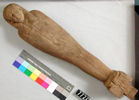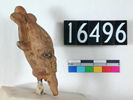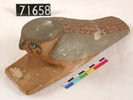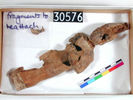| Homepage | Timeline | Maps | A-Z index | Learning |
Wooden figures from Late Period burials
Elite burials of the Twenty-first Dynasty at Thebes often included a wooden Osiris figure which was hollow and contained a funerary papyrus. The figure is mummiform from neck down, and wears the atef crown (the White Crown with additional ostrich feather at either side). In the mid Twenty-second Dynasty these figures disappeared.
In the Late Period, perhaps from around 700 BC, a similar but distinct burial custom appeared throughout Egypt, of placing one or several wooden figures of a composite funerary deity Ptah-Sokar-Osiris in the tomb. These figures wear not the atef crown, but a horizontal pair of horns supporting sun disk and double plume. They do not contain a papyrus, but stand on elongated bases which support facing the figure of the god a box or falcon figure sometimes housing a separate symbol of regeneration. This custom is found into the Ptolemaic Period. Other figures of various gods (Osiris, Isis, Nephthys) occur less often in tombs of the Late Period. Wooden figures of the tomb owner are much rarer, though a few examples are known from the Twenty-fifth to Twenty-sixth Dynasties.
|
from Gurob
|
Hawara
|
unprovenanced
|
||
 |
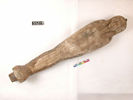 |
|||
